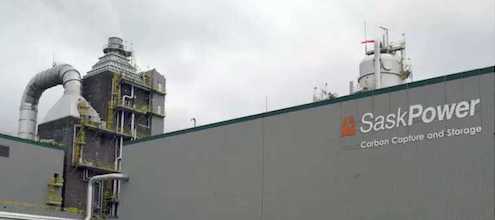
Linking climate policy and economic growth in Saskatchewan

by Craig Alexander and Chris Ragan
Even after last week’s budget, Saskatchewan faces two important economic challenges. The first is to enhance its economic growth, projected to be below the national average this year. The second is to reduce its GHG emissions, currently the highest in Canada in per-capita terms. Addressing either one is tough enough. Getting them both done at the same time may take some powerful magic.
Or will it? Promoting economic growth and reducing GHG emissions can be more closely linked than most people think.
The Saskatchewan government has invested heavily in “carbon capture and storage” (CCS). SaskPower’s Boundary Dam facility is the world’s first commercial-scale lignite-burning generating station equipped with CCS technology. It successfully captured 400,000 tonnes of emissions in its first year, but at a high cost. If this technology could be scaled up significantly and operate at much lower costs, CCS could form a core part of the province’s long-term climate strategy.
This potential justifies Saskatchewan’s large investment. But since using CCS in the electricity sector could only ever apply to about one-fifth of the province’s total GHG emissions, and since there is no guarantee that the investment will pay off, prudence suggests a need for a second policy approach—one that can be reliably used to reduce emissions in all parts of the provincial economy, and at a low cost.
This is where a market-based carbon price enters the picture. With a transparent price or tax on GHG emissions, households and businesses would face a powerful incentive to reduce those emissions. Unlike with more intrusive government regulations, households and businesses would be free to figure out how best to respond to the carbon price, choosing the method that best suits their own circumstance. This flexibility explains why carbon pricing is the lowest-cost way to reduce GHG emissions.
But won’t a carbon price raise costs and damage the economy? Not if the Saskatchewan government used the revenue to reduce personal and business income taxes, a choice embraced by many small-c conservatives across Canada and beyond. It’s a simple principle: raise taxes on the things we don’t want—such as pollution and GHG emissions—while reducing taxes on things we all value: income, saving, and investment.
Reducing income taxes offers a compelling solution to Saskatchewan’s second challenge: increasing economic growth. There is obviously no way any policymaker can restore the world oil price to its 2014 level. But research from many countries shows that taxes on personal and business income are significant impediments to economic growth. There is no reason to think Saskatchewan is different in this respect. Reductions in the province’s income-tax rates would drive more investment, higher wages, and greater productivity.
One obvious problem with advocating income-tax cuts is that the provincial government is projecting a budget deficit of approximately $685 million for the new fiscal year. So the government can’t afford to cut income taxes now, even if it wanted to.
But when we put the two parts of this larger story together, it all becomes possible: If Saskatchewan implemented a carbon price of $30 per tonne that applied to the emission from the combustion of fossil fuels, it would raise about $1.4 billion annually. The government could then use every penny of this revenue to finance a reduction in personal and business income taxes.
This policy combination would leave the budget deficit unchanged, but it would effectively address Saskatchewan’s two challenges. The carbon price would drive a reduction in GHG emissions; the income-tax cuts would drive increases in investment, wages and productivity. And the size of government would be unchanged.
Such a “revenue neutral” carbon price has been successfully working in British Columbia since 2008, which now boasts among the lowest income-tax rates in the country. The result has been a modest reduction in per-capita GHG emissions relative to other parts of the country, and its economy has outperformed those in most other provinces.
Some critics argue that the promise of a revenue-neutral carbon price shouldn’t be believed; governments will happily collect the carbon revenue, but then renege on the promise to reduce income taxes.
But the people of Saskatchewan do not have this problem. Premier Brad Wall is the country’s longest-serving premier for good reason: he is dedicated to protecting the province’s interests and his actions prove that he is very effective at doing so. If there is any Canadian politician who could be trusted to deliver on such a promise, it is surely Mr. Wall.
This piece was originally published by the Regina Leader-Post on April 5, 2017.




1 comment
Hi Chris. Gasoline is up about 16 cents a litre and the Ontario cap-and trade raised over 400 million selling carbon credits. Is Ecophyscal tracking the resulting fossil fuel reductions ? Regards Tom
Comments are closed.